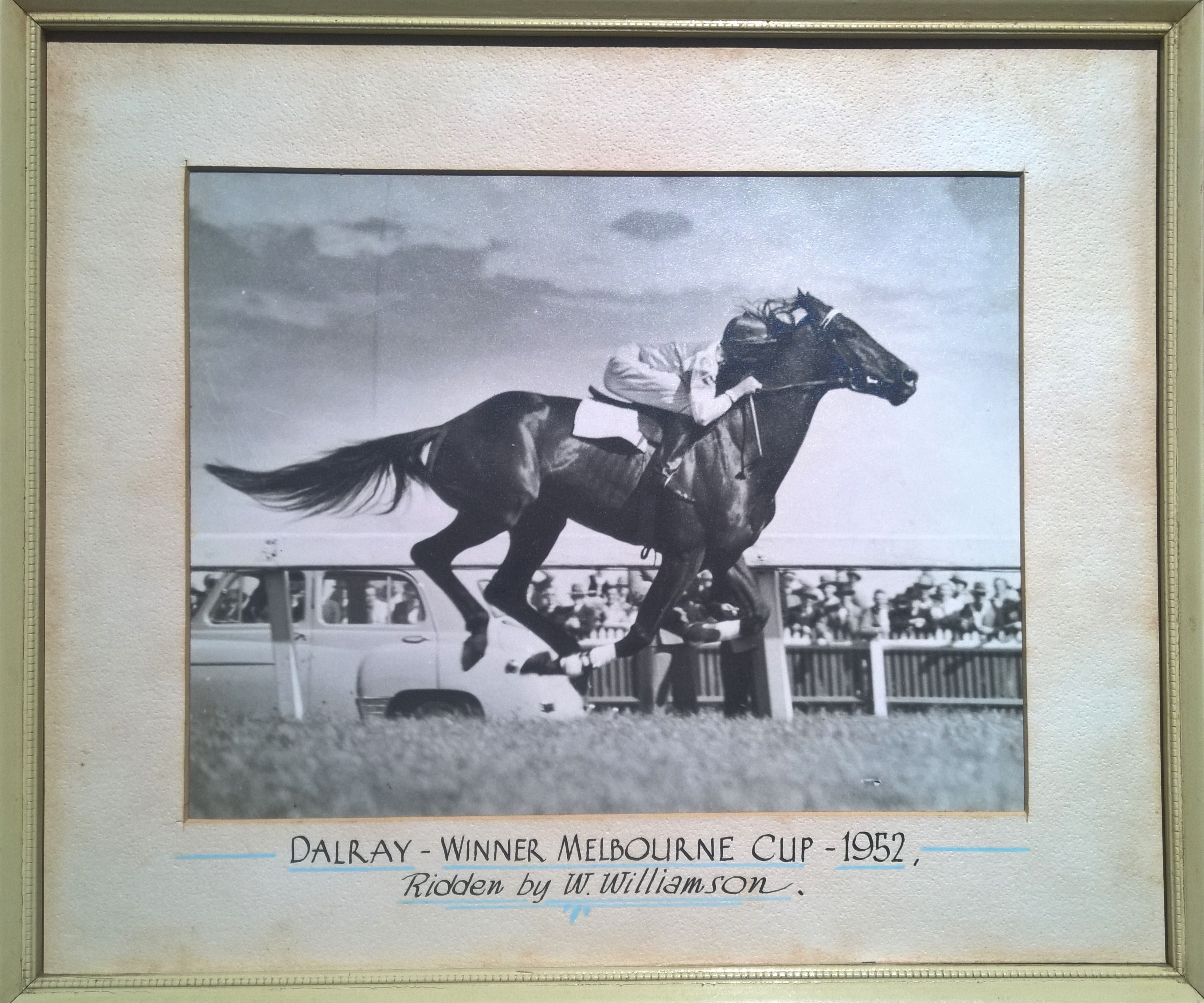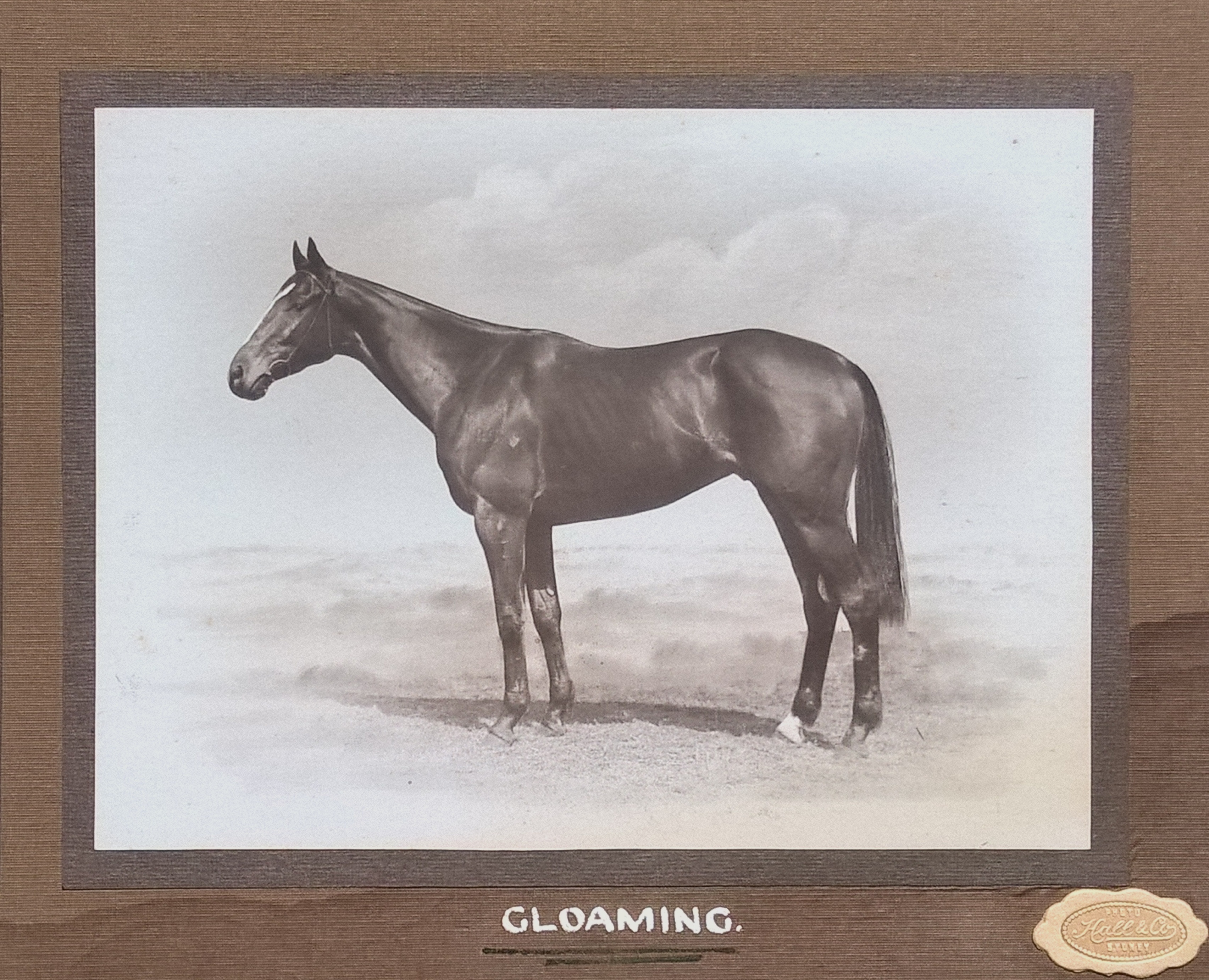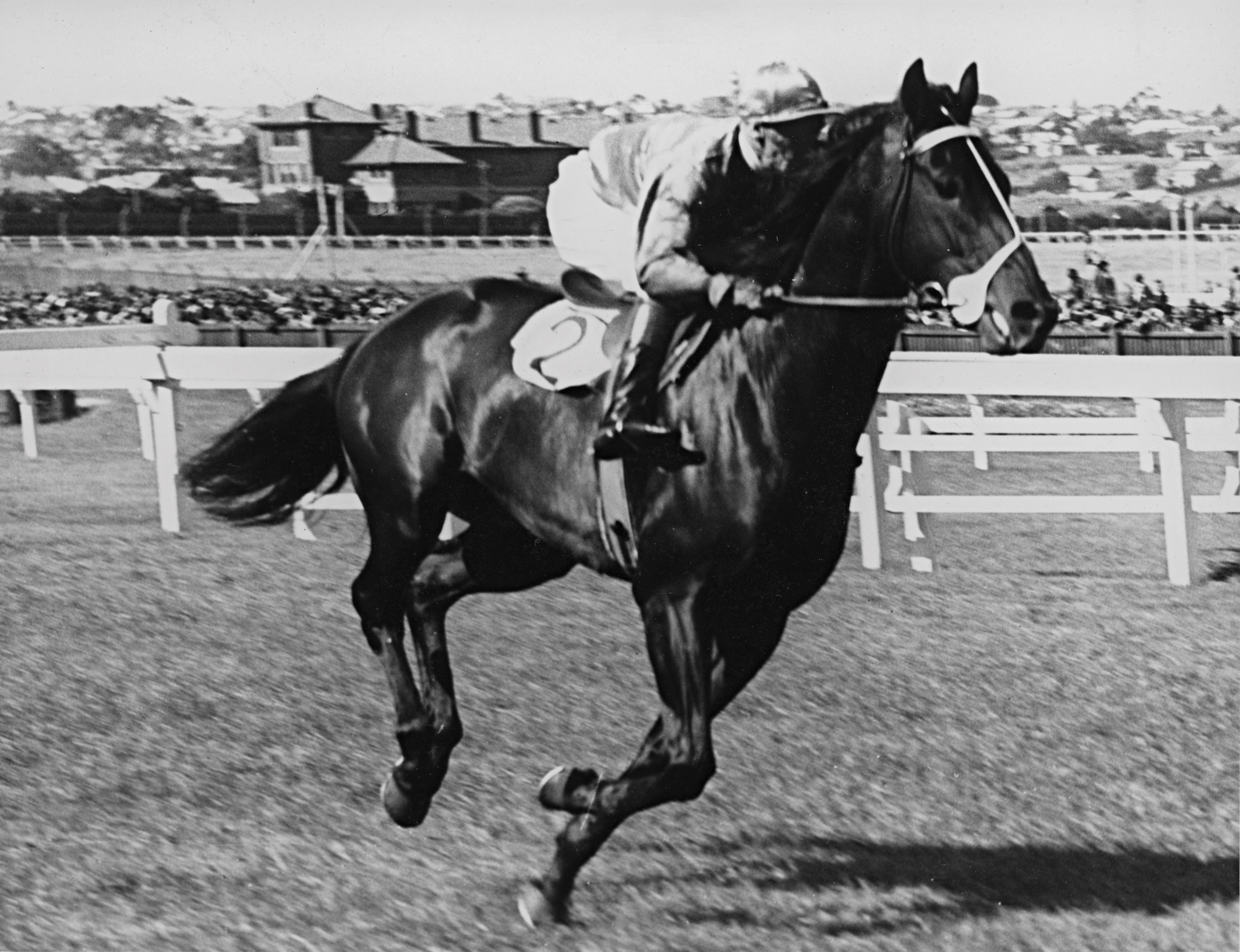|
Dalray
Dalray was a notable New Zealand thoroughbred racehorse who won the 1952 Melbourne Cup and Mackinnon Stakes. Dalray was also famously a ‘certainty’ beaten in the 1952 Sydney Cup. When his owner was quizzed about the defeat he declared "Phar Lap got beaten and Bradman got a duck".Taylor, M. (2002). ''Century of champions : 100 great Australian and New Zealand horses ''. HarperCollinsPublishers (New Zealand) Limited , p. 59 Dalray's career was cut short by injury when he was a four-year-old and he was retired to stud. Amongst his better progeny were Tails (1969 and 1970 Metropolitan Handicap) and Grand Garry (1960 Sydney Cup). Dalray died from a twisted bowel, aged 23. See also * Thoroughbred racing in New Zealand The racing of Thoroughbred horses (or gallopers, as they are also known) is a popular gaming and spectator sport and industry in New Zealand. History Thoroughbred horse racing commenced soon after European settlement. The first totalisator machi ... Cita ... [...More Info...] [...Related Items...] OR: [Wikipedia] [Google] [Baidu] |
Dalray 1952 VRC Melbourne Cup Jockey Bill Williamson Trainer Clarrie McCarthy
Dalray was a notable New Zealand thoroughbred racehorse who won the 1952 Melbourne Cup and Mackinnon Stakes. Dalray was also famously a ‘certainty’ beaten in the 1952 Sydney Cup. When his owner was quizzed about the defeat he declared "Phar Lap got beaten and Bradman got a duck".Taylor, M. (2002). ''Century of champions : 100 great Australian and New Zealand horses ''. HarperCollinsPublishers (New Zealand) Limited , p. 59 Dalray's career was cut short by injury when he was a four-year-old and he was retired to stud. Amongst his better progeny were Tails (1969 and 1970 Metropolitan Handicap) and Grand Garry (1960 Sydney Cup). Dalray died from a twisted bowel, aged 23. See also * Thoroughbred racing in New Zealand The racing of Thoroughbred horses (or gallopers, as they are also known) is a popular gaming and spectator sport and industry in New Zealand. History Thoroughbred horse racing commenced soon after European settlement. The first totalisator machin ... Citatio ... [...More Info...] [...Related Items...] OR: [Wikipedia] [Google] [Baidu] |
Bill Williamson
William James Williamson (19 December 1922 – 28 January 1979) was an Australian jockey who enjoyed considerable success in Australia during the 1950s and in Europe during the 1960s. He was named after his father William James Williamson, a machinist, and his wife Euphemia Agnes. Racing career From a young age he showed considerable interest in horse racing and left Mordialloc-Chelsea High School aged 14 to take up a post as an apprentice jockey. He worked initially under trainer F. H. Lewis who was his great uncle who was the brother of Robert Lewis also a jockey. During this time he met Jack Holt the trainer. He won his first race in 1937 at Lilirene. On 5 January 1942 was called upon to serve in the military, where he worked as a driver with the 119th General Transport Company. Willamson was released two and a half years later on 30 October 1944, when he once again turned to developing his horseracing career. He married Zelma Ava Dickman, a hairdresser on 17 January 194 ... [...More Info...] [...Related Items...] OR: [Wikipedia] [Google] [Baidu] |
New Zealand Derby
The New Zealand Derby is a set-weights Thoroughbred horse race for three-year-olds, run over a distance of 2,400 metres (12 furlongs) at Ellerslie Racecourse in Auckland, New Zealand. It is held on the first Saturday in March, as the opening day of Auckland Cup Week. The purse of the race in 2020 was $1 million. History The New Zealand Derby is an amalgamation of two races – the New Zealand Derby, run since 1860 at Riccarton, Christchurch; and the Great Northern Derby, run since 1875 at Ellerslie Racecourse in Auckland. The races were combined in 1973. Riccarton was awarded two 1,600 m races for three-year-olds in place of its Derby – the New Zealand 2000 Guineas and New Zealand 1000 Guineas. After its May debut, the New Zealand Derby was soon moved to New Year's Day, and then finally to Boxing Day. It continued to be run on this day for many years and became a popular traditional social occasion for Aucklanders until it was moved to the first day of the new Auckland Cup Week ... [...More Info...] [...Related Items...] OR: [Wikipedia] [Google] [Baidu] |
Colin Stephen Quality Handicap
The Colin Stephen Quality Handicap is an Australian Turf Club Group 3 Thoroughbred open quality handicap horse race for horses three years old and older, over a distance of 2400 metres, held annually at Rosehill Racecourse, Sydney, Australia in September. Total prize money for the race is A$200,000. History Name The race is named after the former chairman of the Australian Jockey Club Sir Colin Stephen (1872-1937). Stephen was a solicitor, horse racing administrator, racehorse owner/breeder and polo player. A committee member from 1912 served on the Sir Adrian Knox sub-committee which framed the rules of racing of that year and as chairman of the Australian Jockey Club from 1919, Stephen was determined to make racing in New South Wales a clean and healthy pastime. In 1933 his revised rules were adopted throughout Australia. Sir Colin Stephen’s racing colours of Pale blue, white cap were carried to success by the Ascot Vale Stakes winners Fidelity 1936 & Caesar 1937 defeat ... [...More Info...] [...Related Items...] OR: [Wikipedia] [Google] [Baidu] |
AJC Metropolitan Handicap
The Metropolitan is an Australian Turf Club Group 1 Thoroughbred horse race held under open handicap conditions, for horses aged three years old and older, over a distance of 2,400 metres at Randwick Racecourse, Sydney, Australia in early October. The total prize money for this race is A$750,000. History The race when first run in 1863 was known as the Great Metropolitan Stakes. It is one of the main races in the Sydney Spring Carnival held in early October at Randwick Racecourse, along with the Epsom Handicap. Many great household names have won this race, but none have won the treble of The Metropolitan, Caulfield Cup and Melbourne Cup. Prior to 2004 the race was run on the first Monday in October, the Labour Day holiday. 1942 racebook File:1942 AJC Metropolitan Handicap Racebook P1.jpg, Front page 1942 AJC Metropolitan Handicap racebook. File:1942 AJC Metropolitan Handicap Racebook P2.jpg, 1942 AJC Metropolitan Handicap showing raceday officials. File:1942 AJC Metropol ... [...More Info...] [...Related Items...] OR: [Wikipedia] [Google] [Baidu] |
Great Northern Derby (race)
The Great Northern Derby was a set-weights thoroughbred horse race for three-year-old horses run over a distance of 2400 m at Ellerslie Racecourse in Auckland, New Zealand. It was discontinued in 1972 after being combined with the New Zealand Derby. History The inaugural running of the Derby was in May 1875, when racing was held at Ellerslie Racecourse for the first time. Just three horses took part, of which one was withdrawn before the start and another failed to complete the course, leaving Toi to finish the race and become the first Derby winner. In 1887 it was renamed the ''ARC Great Northern Derby Principal race over 12F'' The race kept the name, the Great Northern Derby, regularly until 1973 when it was combined with the New Zealand Derby from Riccarton (Christchurch) to form one race, called the New Zealand Derby, which was from then onwards run at Ellerslie. Riccarton was instead given two 1600m races for three-year-olds in place of its Derby, the New Zealand 1000 Gu ... [...More Info...] [...Related Items...] OR: [Wikipedia] [Google] [Baidu] |
LKS Mackinnon Stakes
The VRC Champions Stakes, registered as the ''LKS Mackinnon Stakes'', is a Victoria Racing Club Group 1 Thoroughbred horse race run under Weight for Age conditions over a distance of 2000 metres at Flemington Racecourse in Melbourne, Australia on the last day of the Melbourne Cup Carnival, the Saturday after the Melbourne Cup. Total prize money is A$3,000,000. History The race is named after a former chairman of the Victoria Racing Club, Lauchlan Kenneth Scobie ("L.K.S.") MacKinnon (1861–1935). It was originally held on the first day of the Melbourne Cup Carnival, Victoria Derby Day. In 2016, the VRC moved the race as the feature of the last day of the carnival, and moved the Cantala Stakes (the then feature of the last day of the carnival and at the time known as the Emirates Stakes) to the first day of the carnival. After the swap, the race would be known as simply the Emirates Stakes until 2017. Prior to 2016, many horses with a ranking high enough to avoid the ball ... [...More Info...] [...Related Items...] OR: [Wikipedia] [Google] [Baidu] |
Melbourne Cup
The Melbourne Cup is a Thoroughbred horse race held in Melbourne, Australia. It is a 3200-metre race for three-year-olds and over, conducted by the Victoria Racing Club on the Flemington Racecourse in Melbourne, Victoria as part of the Melbourne Spring Racing Carnival. It is the richest "two-mile" handicap in the world and one of the richest turf races. The event starts at 3:00 pm on the first Tuesday of November and is known locally as "the race that stops the nation". The Melbourne Cup has a long tradition, with the first race held in 1861. It was originally run over but was shortened to in 1972 when Australia adopted the metric system. This reduced the distance by , and Rain Lover's 1968 race record of 3:19.1 was accordingly adjusted to 3:17.9. The present record holder is the 1990 winner Kingston Rule with a time of 3:16.3. Qualifying and race conditions The race is a quality handicap for horses three years old and over, run over a distance of 3200 metres, on ... [...More Info...] [...Related Items...] OR: [Wikipedia] [Google] [Baidu] |
Australian Racing Hall Of Fame
The Australian Racing Hall of Fame is part of the Australian Racing Museum which documents and honours the horseracing legends of Australia. The museum officially opened in 1981 and created the Hall of Fame in 2000. The numbers in brackets after each name indicates the year of induction into the Hall of Fame. Racehorses * Abercorn (2018) * Ajax (2004) * Amounis (2006) * Aquanita (2018) * Archer (2017) * Balmerino (2019) * Beau Vite (2021) * Bernborough (Inaugural - 2001) * Better Loosen Up (2004) * Black Caviar (2013) * Briseis (2015) * Carbine (Inaugural - 2001) * Chatham (2005) * Choisir (2015) * Comic Court (2009) * Crisp (2013) * Dalray (2015) * Danehill (2015) * Delta (2013) * Dulcify (2014) * Eurythmic (2005) * Flight (2007) * Galilee (2005) * Gloaming (2004) * Grand Flaneur (2007) * Gunsynd (2005) * Hall Mark (2019) * Heroic (2003) * High Caste (2012) * Karasi (2018) * Kingston Town (Inaugural - 2001) * Leilani (2016) * Let's Elope (2012) * Light Fingers ... [...More Info...] [...Related Items...] OR: [Wikipedia] [Google] [Baidu] |
Thoroughbred Racing In New Zealand
The racing of Thoroughbred horses (or gallopers, as they are also known) is a popular gaming and spectator sport and industry in New Zealand. History Thoroughbred horse racing commenced soon after European settlement. The first totalisator machine in the world was installed at Ellerslie Racecourse in 1913, see Sir George Julius). Thoroughbred racing with the associated aspects such as horse breeding, training and care, race betting, race-day management and entertainment has gradually developed into an industry worth billions of dollars. The governing body is the New Zealand Thoroughbred Racing Incorporated. Race clubs and courses of New Zealand Thoroughbred racing is held throughout New Zealand, including courses in some of the smaller centres. Major Thoroughbred horse races in New Zealand Prominent people For further prominent people in New Zealand thoroughbred racing, see the list of honorees of the New Zealand Racing Hall of Fame. Leading jockeys According to www ... [...More Info...] [...Related Items...] OR: [Wikipedia] [Google] [Baidu] |
New Zealand St
New is an adjective referring to something recently made, discovered, or created. New or NEW may refer to: Music * New, singer of K-pop group The Boyz Albums and EPs * ''New'' (album), by Paul McCartney, 2013 * ''New'' (EP), by Regurgitator, 1995 Songs * "New" (Daya song), 2017 * "New" (Paul McCartney song), 2013 * "New" (No Doubt song), 1999 *"new", by Loona from '' Yves'', 2017 *"The New", by Interpol from ''Turn On the Bright Lights'', 2002 Acronyms * Net economic welfare, a proposed macroeconomic indicator * Net explosive weight, also known as net explosive quantity * Network of enlightened Women, a conservative university women's organization * Next Entertainment World, a South Korean film distribution company Identification codes * Nepal Bhasa language ISO 639 language code * New Century Financial Corporation (NYSE stock abbreviation) * Northeast Wrestling, a professional wrestling promotion in the northeastern United States Transport * New Orleans Lakefront A ... [...More Info...] [...Related Items...] OR: [Wikipedia] [Google] [Baidu] |
Phar Lap
Phar Lap (4 October 1926 – 5 April 1932) was a champion New Zealand–bred Thoroughbred racehorse who is widely regarded as New Zealand's greatest racehorse ever. Achieving incredible success during his distinguished career, his initial underdog status gave people hope during the early years of the Great Depression. He won the Melbourne Cup, two Cox Plates, the Australian Derby, and 19 other weight-for-age races. One of his greatest performances was winning the Agua Caliente Handicap in Mexico in track-record time in his final race. He won in a different country, after a bad start many lengths behind the leaders, with no training before the race, and he split his hoof during the race. After a sudden and mysterious illness, Phar Lap died in 1932 in Atherton, California. At the time, he was the third-highest stakes-winner in the world. His mounted hide is displayed at the Melbourne Museum, his skeleton at the Museum of New Zealand, and his heart at the National Museum of ... [...More Info...] [...Related Items...] OR: [Wikipedia] [Google] [Baidu] |




.jpg)

